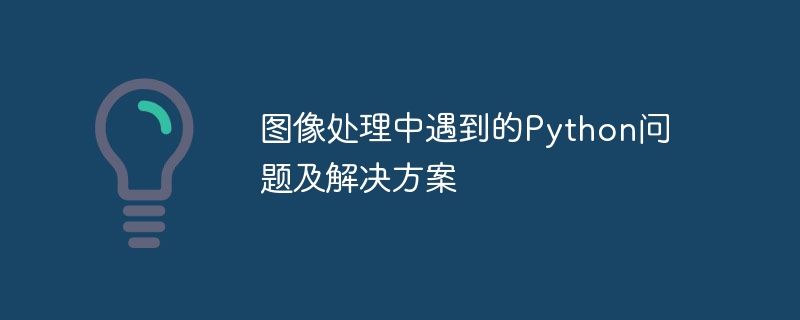

Python problems and solutions encountered in image processing
Abstract: Image processing has a wide range of applications in the fields of computer vision and graphics. Python, as a popular programming language, is also widely used in image processing. However, when we use Python in image processing, we may encounter some common problems. This article will introduce some common Python image processing problems and give solutions and corresponding code examples.
Introduction: Image processing refers to the process of editing, enhancing, analyzing and understanding images. Python provides many powerful image processing libraries, such as OpenCV, PIL and scikit-image. However, we may encounter some common problems when using these libraries.
Question 1: Reading and displaying images
When we use Python for image processing, the first problem to solve is how to read and display images. Python provides many libraries for processing images, among which OpenCV is a very popular choice. The following is a code example for using OpenCV to read and display images:
import cv2
# 读取图像
image = cv2.imread('image.jpg')
# 显示图像
cv2.imshow('Image', image)
cv2.waitKey(0)
cv2.destroyAllWindows() Question 2: Adjust image size
In image processing, it is often necessary to adjust the size of the image to adapt to different needs. The following is a code example that uses OpenCV to resize an image to a specified size:
import cv2
# 读取图像
image = cv2.imread('image.jpg')
# 调整图像大小
resized_image = cv2.resize(image, (800, 600))
# 显示调整大小后的图像
cv2.imshow('Resized Image', resized_image)
cv2.waitKey(0)
cv2.destroyAllWindows()Question 3: Image filtering
Image filtering is one of the important tasks in image processing, used to remove noise and smooth images. The following is a code example using OpenCV to filter images:
import cv2
# 读取图像
image = cv2.imread('image.jpg')
# 将图像转换为灰度图
gray_image = cv2.cvtColor(image, cv2.COLOR_BGR2GRAY)
# 对灰度图进行高斯滤波
blurred_image = cv2.GaussianBlur(gray_image, (5, 5), 0)
# 显示滤波后的图像
cv2.imshow('Blurred Image', blurred_image)
cv2.waitKey(0)
cv2.destroyAllWindows() Question 4: Image edge detection
Image edge detection is often used to extract edge information in image processing. The following is a code example of using OpenCV for image edge detection:
import cv2
# 读取图像
image = cv2.imread('image.jpg')
# 将图像转换为灰度图
gray_image = cv2.cvtColor(image, cv2.COLOR_BGR2GRAY)
# 对灰度图进行Canny边缘检测
edges = cv2.Canny(gray_image, 100, 200)
# 显示边缘图像
cv2.imshow('Edges', edges)
cv2.waitKey(0)
cv2.destroyAllWindows() Question 5: Image segmentation
Image segmentation is one of the important tasks in image processing and is used to decompose the image into several sub-regions. The following is a code example for image segmentation using scikit-image:
from skimage import segmentation
import matplotlib.pyplot as plt
# 读取图像
image = plt.imread('image.jpg')
# 对图像进行分割
segments = segmentation.slic(image, n_segments=100)
# 显示分割后的图像
plt.imshow(segments)
plt.axis('off')
plt.show()Conclusion: This article introduces common Python problems in image processing and provides corresponding solutions and code examples. By learning and mastering these solutions, we can better utilize Python for image processing and achieve better results in practical applications. Image processing is a vast and complex field. I hope this article can provide some help to readers in Python programming in image processing.
The above is the detailed content of Python problems encountered in image processing and solutions. For more information, please follow other related articles on the PHP Chinese website!
 What is a root domain name server
What is a root domain name server
 Can the c drive be expanded?
Can the c drive be expanded?
 What should I do if gpedit.msc cannot be opened?
What should I do if gpedit.msc cannot be opened?
 Permanently free oa system
Permanently free oa system
 What language is c language?
What language is c language?
 Unable to locate program input point in dynamic link library
Unable to locate program input point in dynamic link library
 How to calculate the refund handling fee for Railway 12306
How to calculate the refund handling fee for Railway 12306
 ICP coin prospect analysis
ICP coin prospect analysis




